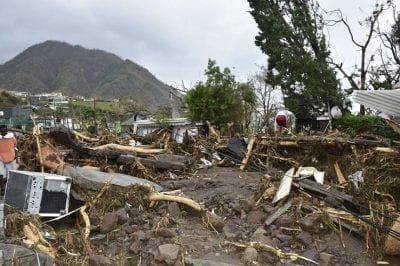EE&G was retained by The School Board of St. Lucie County to provide emergency response services after the impact of Hurricanes Frances and Jeanne. As a result of significant water intrusion, EE&G managed and conducted a massive cleanup operation which included a room-by-room, building-by-building assessment, and remediation of water-damaged materials and Assumed Mold Growth (AMG) in 39 schools. The remediation aspect of the project involved selective demolition of building materials and subsequent re-build.
The purpose of the project was to improve the indoor air quality for St. Lucie County school children and staff. In order to provide optimum indoor air quality, EE&G selectively demolished water-impacted materials (i.e., drywall/sheetrock, carpet, floor tiles, ceiling, etc.) and evaluated HVAC systems and building envelopes to assess possible areas of water/moisture intrusion. Additionally, the project involved selective exterior demolition on 60 portable classrooms and demolition of approximately 90 portables where the costs to remediate exceeded the replacement costs.
EE&G provided the following services:
- Comprehensive inspection and assessment of 39 schools and related offices to determine drywall/sheetrock and other building materials be removed.
- Developed a written scope of work and procured the services of qualified contractors employing nearly 800 persons for drying and dehumidification, demolition of water damaged building materials, replacement of building materials and cleaning of all non-porous materials.
- Duct Cleaning
- Provided turn-key design/building services.
- Supervised asbestos abatement and conducted air monitoring.
- Coordinated project with School District’s facility management.
- Provided project communication liaison with principals, County and EE&G.
- Presented IAQ information at the press conference on behalf of School District.
Hurricane Frances was the second most intense tropical cyclone in the Atlantic during 2004 that proved to be very destructive in Florida. The sixth named storm, the fourth hurricane, and the third major hurricane of the 2004 Atlantic hurricane season. The system crossed the open Atlantic in mid and late August, moving to the north of the Lesser Antilles while strengthening. Its outer bands struck Puerto Rico and the British Virgin Islands while passing north of the Caribbean Sea. The storm’s maximum sustained wind peaked at 145 mph (233 km/h), achieving Category 4 on the Saffir-Simpson Hurricane Scale. As the system’s forward motion slowed, the eye passed over San Salvador Island and very close to Cat Island in the Bahamas. Frances was the first hurricane to impact the entire Bahamian archipelago since 1928, and almost completely destroyed the agricultural economy there.
Frances then passed over the central sections of Florida, in the United States, three weeks after Hurricane Charley, causing significant damage to the state’s citrus crop, closing major airports and schools, and forcing the cancellation of a collegiate football game. The storm then moved briefly offshore from Florida, into the northeast Gulf of Mexico, and made a second U.S. landfall, at the Florida Panhandle, before accelerating northeast through the eastern United States near the Appalachians and into Atlantic Canada while weakening. A significant tornado outbreak accompanied the storm across the eastern United States, nearly equaling the outbreak from Hurricane Beulah. Very heavy rains fell in association with this slow-moving and relatively large hurricane, which caused floods in Florida and North Carolina. Some 49 people died from the cyclone. Damages totaled US$10.1 billion (2004 dollars).

